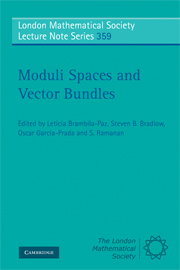Book contents
- Frontmatter
- Contents
- Preface
- Acknowledgments
- Part I Lecture Notes
- Part II Survey Articles
- 7 Moduli of Sheaves from Moduli of Kronecker Modules
- 8 Coherent Systems: a Brief Survey
- 9 Higgs Bundles Surface and Group Representations
- 10 Quotients by Non-Reductive Algebraic Group Actions
- 11 Dualities on T*SUX (2, OX)
- 12 Moduli Spaces for Principal Bundles
- Part III Research Articles
8 - Coherent Systems: a Brief Survey
Published online by Cambridge University Press: 07 September 2011
- Frontmatter
- Contents
- Preface
- Acknowledgments
- Part I Lecture Notes
- Part II Survey Articles
- 7 Moduli of Sheaves from Moduli of Kronecker Modules
- 8 Coherent Systems: a Brief Survey
- 9 Higgs Bundles Surface and Group Representations
- 10 Quotients by Non-Reductive Algebraic Group Actions
- 11 Dualities on T*SUX (2, OX)
- 12 Moduli Spaces for Principal Bundles
- Part III Research Articles
Summary
Dedicated to Peter Newstead on the occasion of his 65th birthday.
Introduction
A coherent system is a pair (E, V) where E is a holomorphic bundle and V is a linear subspace of its space of holomorphic sections. If E is a semistable bundle, then the existence of such objects is equivalent to the non-emptiness of a higher rank Brill-Noether locus. This connection to higher rank Brill-Noether theory provides one of the motivations for studying coherent systems. It certainly motivated Peter Newstead's guiding role in the development of the subject, and thus makes a volume in honor of his 65th birthday a fitting place for a survey.
Interest in coherent systems extends beyond Brill-Noether theory, mainly because there is a stability notion for a pair (E, V), distinct from the stability of the bundle E. The natural definition of such stability depends on a real parameter (denoted by α) and leads to a finite family of moduli spaces of α-stable coherent systems. These moduli spaces present a rich display of topological and geometric phenomena, most of which have yet to be fully explored.
This survey will be limited in scope because of space constraints and because of a survey in preparation by Peter Newstead based on his lectures at a Clay Institute workshop held in October 2006 ([N]).
- Type
- Chapter
- Information
- Moduli Spaces and Vector Bundles , pp. 229 - 264Publisher: Cambridge University PressPrint publication year: 2009
- 6
- Cited by



